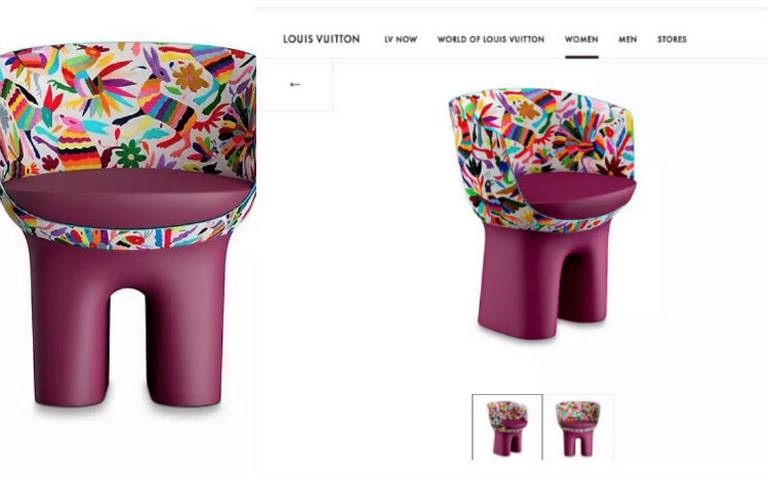French fashion house Louis Vuitton features Oaxacan handcrafted designs
Renowned French firm Louis Vuitton integrated into its designs the color, culture, and artistic expression of Mexican artisans, specifically those of San Martin Tilcajete, Oaxaca.

The famous French firm Louis Vuitton integrated into its designs the color, culture, and artistic expression of Mexican artisans, specifically those from San Martin Tilcajete, Oaxaca. This collection, which is curated by Natalia Herrera, innovative culture and CEO of Atelier Cultural Mexico, consists of six trunks and a classic Volkswagen, which were intervened with paintings of tonas and nahuales representative of this municipality.
"In this community, almost everyone is dedicated to the carving of these figures. However, I selected for this commission the workshop Casa Don Juan for the excellence and perfection of the work of their master craftsmen (...) and for the social impact they have had in their community, since, in their case, the trade is shared with young people who need to bring sustenance to their homes," revealed Herrera.
This is the first time the French firm has collaborated with Mexican talent. Each trunk took approximately one month to paint, and in Louis Vuitton, symbolism and the bodies of the tones are full of references to the beauty of nature.
Louis Vuitton signs a former Swarovski as director for Mexico, Panama, and Aruba
Gregorio Jiménez Castillo has been signed by the French luxury company, owned by the giant LVMH, to pilot the company's business in the Mexican market, Central America, and the Caribbean. A marketing graduate from the Instituto Tecnológico de Monterrey, Jiménez has dedicated his entire career to fashion retailing. He joined L'Oréal in 2000 where he held various positions of responsibility for several brands in the cosmetics group.
In 2012, Jiménez joined Swarovski as a director in Mexico, and in 2017 he also took control of the Austrian cut crystal company in the rest of Latin America. Now, the manager will be based in Mexico to pilot Louis Vuitton's operation in the country, as well as in Panama and Aruba. Jiménez has taken over from Spain's Miguel Vargas, who was promoted to director of Louis Vuitton in the southeastern United States. Vargas joined Louis Vuitton in 2016 from Sociedad Textil Lonia, where he was a director in Mexico of Purificación García and CH Carolina Herrera for two years.
Jiménez's new challenge will be to pilot one of Louis Vuitton's main markets in Latin America, where the luxury fashion company operates single-brand stores, a flagship store on Avenida Masaryk in Mexico City, and points of sale in the departments of El Palacio de Hierro. In the last two years, the French company has expanded into several countries in the region. Louis Vuitton will leave permanent the pop-up store that opened in the past in the Patio Bullrich shopping center in Buenos Aires.
The luxury fashion and accessories company also raised its bet on Colombia recently with the opening of a flagship in the Andino shopping center in Bogota, in the place previously occupied by Ermenegildo Zegna. The company also has a presence in Chile and Brazil and previously had a store in Punta del Este, Uruguay.

Mexico asks Louis Vuitton to clarify the design of a chair
The Ministry of Culture asked Louis Vuitton to clarify the design of a chair that forms part of its Dolls by Raw Edges collection. "We have learned with surprise that in the Dolls by Raw Edges collection of his firm, there is a chair (model R98619) that reproduces elements that are part and are identified with the embroideries that are made and are the intellectual property of the community of Tenango de Doria, in the state of Hidalgo, as well as its artisans," said the secretariat in a letter dated July 5, sent to Héctor Pardo, director of Communication of the firm.
The head of the agency, Alejandro Frausto, proposes that the firm hold a dialogue in which Mexican cultural authorities, artisans and businesses participate, with the aim of reaching agreements that benefit all those involved. In addition to giving due recognition to the community in which the cultural appropriation took place. Last April, the French fashion house launched on the market a collection of designer chairs in collaboration with the studio Raw Edges, among which stands out a decorated with colorful motifs typical of the designs of Tenango de Doria, Hidalgo.
The chair was offered on Louis Vuitton's website at a price of 12,800 pounds sterling, more than three hundred thousand Mexican pesos. Senator Susana Harp proposes initiatives for the protection of the collective intellectual property and cultural rights of the country's indigenous peoples. "So, you say: "if Louis Vuitton signs it, it's worth it, it's a Tenango de Doria. Indeed, we have to reflect as Mexicans and re-evaluate and reflect on what's going on with our cultures," she said.
Harp considered that it is good to have collaborations with the big brands or with the big designers; however, the first thing that the communities have always asked them to do when they have approached them to talk to them about the subject, is respect because that is where their cosmovision is embodied.
"That's what we want: to invite all these people who want to do things, to do them together with the communities; it's not that they don't touch it, but that they are there and that they have respect for them," she said.
She affirmed that "they are always going to have to get closer to the communities; suddenly that is what they want: to skip that stretch and that is what they are not worth because the Mexican State will be able to shelter, accompany, advise, but the owners of these cultural elements have a name and have a location, and we have to go with them respectfully to know that yes, how, when, in what terms.




